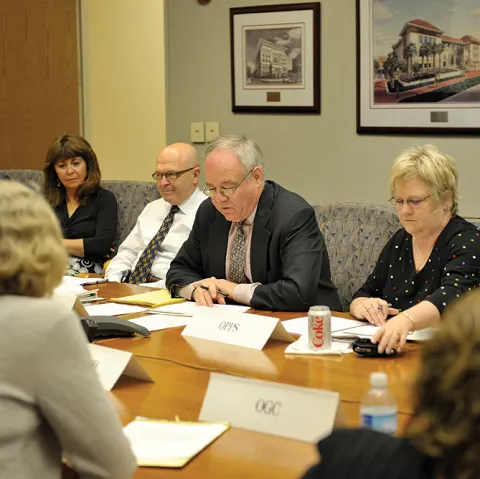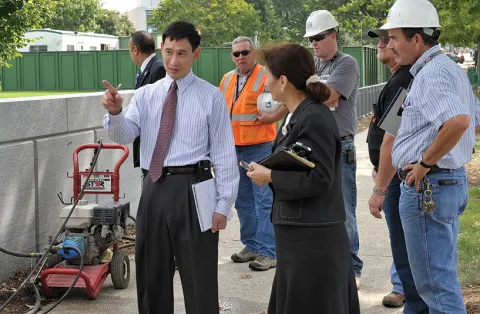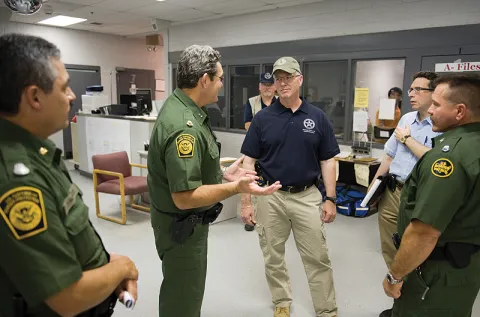
Facilities and security initiatives emphasized preparations for a possible influenza pandemic, assuring workforce security throughout the Judiciary, and support to courts affected by natural disasters.
Remote Detention of Pretrial Detainees
In 2008, an Ad Hoc Remote Detention Group was formed to address the issue of where federal pretrial defendants are housed and the impact it is having on the criminal justice system. Representatives to the group are from the Judicial Conference Committees on Judicial Security, Defender Services, Criminal Law, and the Budget, court unit executives, and executive branch personnel, including staff from the USMS and the Office of the Federal Detention Trustee (OFDT). The group met several times and discussed current policy considerations and practices of the USMS and OFDT in determining where to house pretrial detainees, concerns of the Judiciary, particularly with respect to remote placement of pretrial detainees, the problems of access and costs incurred by federal defenders and CJA panel attorneys and pretrial services and probation staff in visiting detainees; and possible solutions to these problems. After the first meeting, representatives from the Bureau of Prisons and the Executive Office for U.S. Attorneys joined the ad hoc group.
The group gathered information from districts about the severity of particular remote detention problems via a “self-evaluation” survey, which was developed by the group and administered by the OFDT. After reviewing the results and other detention information, the group’s primary recommendation was that each district should create a District Detention Committee (DDC) to allow for better coordination and greater influence in mitigating existing and potential remote detention issues.
The group oversaw creation of a website rolled out in August, www.ddcworksite.com, which allows users to look at their individual district’s data, national data, and their severity ranking. A white paper includes suggestions on how to address remote detention problems within a district and suggested actions grouped by severity ratings.
New Judge Identification Cards
In January 2009, the AO began issuing new ID cards to all United States judges and circuit executives on a circuit-by-circuit basis. The new cards were designed and approved by the Judicial Conference Committee on Judicial Security to replace the ID card for federal judges that was created in 1996. The new judge ID card is in full compliance with the Transportation Security Administration regulations for use as the sole form of airport identification as long as judges agree to include date of birth and gender information on the card. The card was required to have an expiration date and a serial number that can be tracked in the event it is lost or stolen.
Emergency Preparedness and Pandemic Response
The AO continued to assist the courts in emergency preparedness efforts through training initiatives and by responding to natural events that affect judicial employees and operations and cause damage to facilities and equipment. As part of those preparations, the AO has provided guidance to courts concerning continuity and pandemic influenza preparedness. Nearly all courts have finished a pandemic annex as an integral part of their continuity of operations plans. Over 30 probation and pretrial services offices have established Critical Incident Stress Management response teams.
At the Administrative Office, pandemic response plans were tested, including an agency-wide telework test to verify the AO’s ability to work remotely without disruption in services and support to the Judiciary.
Continuity Conferences Focus on Preparedness and Response
With the support of the FJC, and a training program planning team, the AO coordinated a program of instruction for the Ninth Circuit Continuity Conferences in January and March 2009. Similar training was conducted for the First and Second Circuits in 2009, and is planned for the Third Circuit in summer 2010.
H1N1 Outbreak Triggers Response
In April and May of 2009, the outbreak of H1N1 influenza forced many communities to consider appropriate responses, including increased awareness, hand sanitizing, social distancing, and school closures. The AO participated in a Cross-Sector Coordination Planning Conference held in Indianapolis, Indiana in June, and assisted the Southern District of Indiana, a co-sponsor of the event. In addition to representatives from the district court, other federal organizations represented included FEMA, the Centers for Disease Control and Prevention, GSA, USMS, and the National Archives and Records Administration.
The AO broadcasted the conference live from Indianapolis. Training materials from the conference have been made available to district courts interested in similar planning and community coordination.
In July 2009, AO staff attended the White House H1N1 Influenza Preparedness Summit at the National Institutes of Health. The purpose of the summit was to share the latest information on the behavior of the virus and suggested community responses to a second wave of infections. In August 2009, AO staff conducted a nationwide court survey to identify major concerns, issues, and questions pertaining to preparation and response in a pandemic flu situation. Staff received more than 400 responses to the survey. After the AO reviewed results, a panel of experts conducted a series of H1N1 conference calls for all circuits on issues related to human capital, communications, telework, law enforcement and health services.
Emergency Response Team Helps Court Affected by Natural Disaster
Advance testing of occupant emergency and continuity plans helped prepare the North Dakota District Court in Fargo cope with severe storms and Red River flooding in March 2009. Court operations were quickly relocated to Bismarck. The Judiciary Emergency Response Team provided support to judges and court managers in addressing this weather disaster.
Thurgood Marshall Federal Judiciary Building Perimeter Security

A perimeter security installation is bringing the Administrative Office’s Washington, DC building up to standards for federal facility security.
The Administrative Office of the U.S. Courts (AO) in conjunction with the Architect of the Capitol (AOC) is implementing perimeter security upgrades for the Thurgood Marshall Federal Judiciary Building (TMFJB). The upgrades will improve the safety and security of building occupants and visitors by installing bollards around the building perimeter and vehicular delta barriers at building entry points. The project is expected to be completed in early 2010.
Emergency Notification
The Emergency Notification System (ENS), developed by AO staff with substantial court input, helps courts and the AO notify staff of emergencies and to verify staff safety in emergencies. Court staff can be reached during or after work hours via work or home phone, work or personal email, and work or personal cell phone.
The system’s value was demonstrated many times over during FY 2009. In over 80 instances, courts used the ENS to advise personnel of courthouse closures or delayed openings due to weather, power loss, street closings, and other events. The ENS proved to be a great tool during Hurricane Gustav, and for drills and training exercises. The AO has used the system this past year to notify employees and staff during building emergencies; prepare for the presidential inauguration; and to share Department of Homeland Security changes in security level.
Southwest Border Conferences

Five judicial districts along the U.S.-Mexico border have had to address a massive increase in workload and a rise in threats to security for judges and court staff. Congress provided supplemental funding during 2009 to enhance security.
In March 2009, the Judicial Security Committee hosted a one-day border security meeting with southwest border judges. At the meeting, the USMS and other law enforcement agencies briefed judges on threats and violent activity in Mexico, and discussed possible security measures to step up protection of judges.
Director Duff and USMS Director John Clark visited the Southwest border in July for a firsthand assessment of the courts’ workload and security needs. There have been significant increases in the workload of the five judicial districts adjacent to the border with Mexico, along with reports of border violence and its possible implications for the security of judges. The trip began in Tucson, Arizona and concluded in El Paso, Texas. In Tucson alone, felony cases and defendants increased by almost 50 percent from the previous fiscal year. The Border Patrol, with increased growth and resources, has been assisting the USMS in its efforts to protect the Judiciary. El Paso faces different challenges from Tucson because of its location right at the border. Judges there have dealt with anonymous juries because family members of a jury who reside in Mexico can be victims of intimidation or retaliation. The Director visited the El Paso Intelligence Center (EPIC) and received a briefing on the center’s infrastructure.
The USMS received $4 million in supplemental funding during the latter half of FY 2009 to assist with security along the border. A number of programs will improve security for all members of the Judiciary in the southwest border districts. Security will be enhanced for judges’ work and home locations. An additional $10 million was provided to the Judiciary for border security through September 30, 2010.
In November 2009, the southwest border judges and chief probation and pretrial services officers convened again to discuss the USMS judicial protection strategy and enhancements, current intelligence regarding Mexican drug cartel activity, immigration enforcement along the border, and strategies to address detention issues.
Rent Validation and Related Efforts
To ensure that courthouse rent bills are accurate, a national rent validation program has been underway for the last few years. This program entails verifying the accuracy of rent bills for each court, challenging rental rates where applicable, and educating court employees so they can monitor their GSA rent bills and verify any future changes to the rent bills and space assignments. The work associated with validating the rent bills is complete, with much of the remaining effort focused on working with the GSA to ensure that appropriate rent adjustments and credits are applied to the rent bill. To date, the Judiciary has saved over $60 million dollars in GSA rent adjustments and credits. As a follow-on to the rent validation work that has been accomplished, the Northern District of New York and the AO have partnered to develop and implement a strategy to validate the accuracy of the appraisals that GSA uses to determine the rental rates it charges to the Judiciary in federally-owned facilities.
A tool in that effort is JRent, web-based software developed by New York-Northern and the AO and implemented at the start of fiscal year 2009 to help courts monitor their space rental costs. A searchable online database of past and current rent bill information is available to court and AO staff in a user-friendly format. Space-related documentation is also provided, along with a user guide and some options to personalize screen views of data. New software features will be added to enhance the tool during 2010.
Now that asset management and space validation programs are in place, a National Space and Security Circuit Training program is being developed to help courts manage their space. With the help of 10 court managers and the FJC, specific space and facilities training needs were identified in five areas: circuit rent budgets, courtroom technology and communications, asset management planning, rent validation, and space and facilities planning. Court officials from the Second Circuit participated in a pilot of the training program in September 2009. The next training session will be provided to the Fifth Circuit court units.
Annual Report 2009
- Annual Report 2009
- Legislative Activity
- Direct Impact On The Public
- Judges Programs
- Facilities, Security, and Emergency Planning
- Business Improvements, Studies, and Activities
- Key Studies and Activities
- Human Resources
- Technology
- Probation and Pretrial Services
- Defender Services
- Communications
- In Profile
- A Strategic Direction For The Administrative Office of the United States Courts, Fiscal Years 2009–2013
